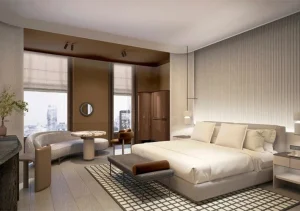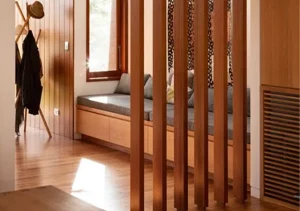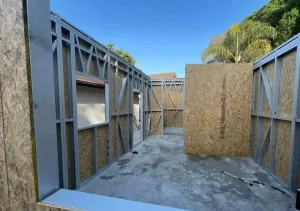Table of Contents
ToggleIntroduction
In the field of modern interior design, materials are not only valued for their aesthetic appeal but also for their durability, environmental friendliness, and functional properties. One material that has gained significant popularity in recent years is bamboo charcoal wood veneer. This innovative decorative surface combines the natural beauty of wood with the advanced performance of bamboo charcoal technology, making it a top choice for interior designers, architects, and homeowners alike.
As the demand for sustainable and high-quality decorative materials increases worldwide, bamboo charcoal wood veneer stands out for its balance of functionality and style. This article will provide a comprehensive introduction to this material, focusing on its features, advantages, applications, and its role in shaping the future of interior design.
What is Bamboo Charcoal Wood Veneer?
Bamboo charcoal wood veneer is a type of decorative surface material produced by integrating bamboo charcoal powder into a wood-based panel substrate, then overlaying it with a high-quality veneer surface. It is not only visually attractive but also enhanced with functional characteristics such as odor absorption, humidity regulation, and antibacterial properties.
- Base material: MDF, plywood, or other engineered boards.
- Additive: Bamboo charcoal powder, known for its air-purifying qualities.
- Surface finish: Wood veneer, with patterns that replicate natural wood grains.
This combination ensures that bamboo charcoal wood veneer provides both a luxurious wooden appearance and functional benefits superior to traditional veneers.
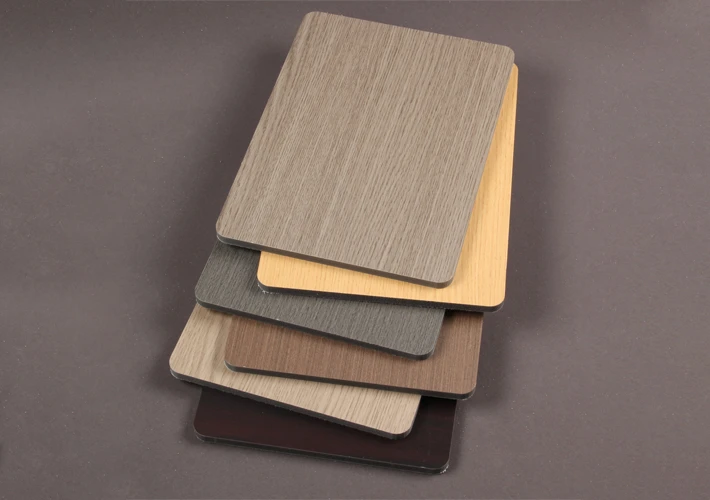
Key Features of Bamboo Charcoal Wood Veneer
1. Natural Wood Grain Appearance
The veneer surface reproduces the warm, elegant look of natural wood, which adds a sense of luxury and sophistication to interiors. From light oak tones to rich walnut shades, it offers a wide range of decorative options.
2. Air-Purifying Ability
Thanks to the bamboo charcoal component, the veneer has an excellent ability to adsorb harmful substances like formaldehyde, benzene, and odors in indoor environments. This makes it particularly suitable for residential and commercial projects with high air quality requirements.
3. Moisture and Humidity Control
Bamboo charcoal is a naturally porous material that helps regulate indoor humidity. It absorbs excess moisture in humid conditions and releases it when the air becomes too dry, maintaining a balanced indoor climate.
4. Antibacterial and Antifungal Properties
The activated carbon particles in bamboo charcoal wood veneer inhibit the growth of bacteria and mold. This makes it ideal for places where hygiene is crucial, such as hotels, hospitals, and kitchens.
5. Fire Resistance and Durability
Compared with ordinary decorative veneers, bamboo charcoal veneer is more resistant to fire and high temperatures. Its durable structure also ensures long-lasting use without easy deformation or fading.
6. Eco-Friendly Material
Bamboo is one of the fastest-growing plants in the world and a renewable resource. The integration of bamboo charcoal into decorative panels makes this material highly eco-friendly, aligning with the global trend toward sustainable construction and design.

Advantages of Using Bamboo Charcoal Wood Veneer in Interior Design
Aesthetic Advantages
- Offers diverse wood grain patterns for premium visual effects.
- Enhances the atmosphere of luxury and comfort in residential and commercial spaces.
- Can be customized in textures, colors, and finishes to match specific design themes.
Functional Advantages
- Acts as a natural air filter, improving indoor health.
- Provides long-term durability with scratch resistance and fire resistance.
- Maintains a stable indoor environment by regulating humidity.
Economic Advantages
- More cost-effective than solid natural wood panels.
- Longer lifespan reduces the need for frequent replacements.
- Increases property value by adding a high-end, functional decorative element.
Environmental Advantages
- Made from renewable bamboo resources.
- Reduces indoor pollution by absorbing harmful gases.
- Meets international green building certification requirements (such as LEED).
Applications of Bamboo Charcoal Wood Veneer in Interior Design
1. Residential Interiors
- Living Rooms: Used as wall panels, TV backgrounds, and ceiling decorations to create a warm and inviting atmosphere.
- Bedrooms: Provides a clean and healthy sleeping environment by purifying the air.
- Kitchens: Ideal for cabinetry and wall finishes due to its antibacterial and moisture-resistant properties.
2. Commercial Spaces
- Hotels: Enhances guest rooms, lobbies, and corridors with both elegance and functionality.
- Offices: Improves air quality, boosting employee productivity and well-being.
- Restaurants: Adds an upscale wooden look while ensuring a hygienic environment.
3. Public Institutions
- Hospitals and Clinics: The antibacterial and odor-absorbing features contribute to a healthier space.
- Educational Facilities: Provides safe, eco-friendly, and durable surfaces for classrooms and libraries.
4. Luxury Projects
- High-end Villas: Combines luxury and health-focused living.
- Resorts and Spas: Enhances relaxation environments by regulating air and humidity.
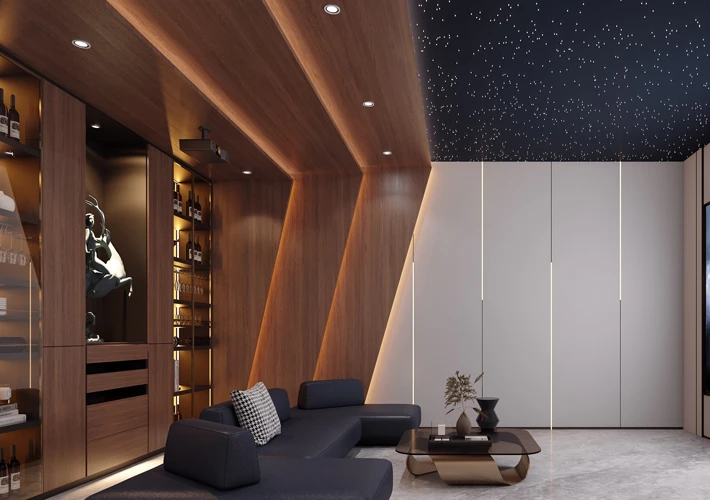
Comparison with Other Decorative Materials
| Feature | Bamboo Charcoal Wood Veneer | Traditional Wood Veneer | PVC Marble Sheet | Acoustic Panel |
|---|---|---|---|---|
| Appearance | Natural wood grain | Natural wood grain | Marble/stone patterns | Wood/cloth finish |
| Air Purification | ✔ | ✘ | ✘ | Limited |
| Humidity Control | ✔ | ✘ | ✘ | Limited |
| Antibacterial | ✔ | ✘ | ✘ | ✔ (some types) |
| Fire Resistance | High | Medium | Medium | High |
| Eco-Friendly | ✔ | Limited (depends on wood) | Medium | Medium |
This comparison highlights why bamboo charcoal wood veneer is increasingly chosen by designers worldwide.
Market Demand and Development Trends
Rising Demand in International Markets
With growing awareness of sustainable design and health-focused living, bamboo charcoal wood veneer has seen increasing demand in regions like Europe, North America, and the Middle East. Clients are looking for decorative materials that combine beauty with functionality.
Innovation in Design and Technology
Manufacturers are constantly improving production techniques, offering:
- Thinner and lighter veneer sheets.
- Wider range of customizable patterns.
- Enhanced fireproof and waterproof technologies.
Future Market Prospects
The bamboo charcoal wood veneer industry is expected to expand significantly in the next decade, driven by:
- Green building policies.
- Health-conscious consumer preferences.
- Demand for eco-friendly alternatives to traditional materials.
Installation and Maintenance
Installation Guidelines
- Use professional adhesive for firm bonding.
- Ensure the substrate surface is flat and clean.
- Allow for expansion and contraction in humid environments.
Maintenance Tips
- Regularly clean with a soft, dry cloth.
- Avoid prolonged exposure to direct sunlight.
- Refinish the surface with protective coatings to extend lifespan.

Why Choose Us as Your Supplier?
As a professional bamboo charcoal wood veneer manufacturer and exporter in China, we offer:
- High-quality products with consistent standards.
- Factory-direct prices that ensure competitiveness.
- OEM & customization services for diverse project needs.
- Efficient export logistics to deliver materials worldwide.
Our expertise in decorative materials guarantees not only superior products but also reliable support for your interior design projects.
Conclusion
Bamboo charcoal wood veneer represents a perfect balance of beauty, sustainability, and functionality. With its air-purifying, antibacterial, and eco-friendly characteristics, it goes far beyond ordinary decorative veneers. Whether in residential, commercial, or luxury spaces, it delivers both aesthetic value and health benefits.
As the demand for sustainable and high-performance materials continues to grow, high-quality bamboo charcoal wood veneer is set to play a central role in the future of interior design. For architects, designers, and distributors seeking a versatile and innovative solution, this material is undoubtedly a smart choice.


